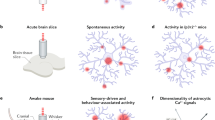Abstract
Astrocytes display diverse and frequent intracellular Ca2+ fluctuations that are separable by virtue of their location within the cells, their magnitude, and their duration. Recently, the study of astrocyte Ca2+ signaling has rapidly advanced by the availability of genetically encoded Ca2+ indicators (GECIs) such as GCaMP3 and GCaMP6. The systematic use of GECIs is beginning to reveal the rules for astrocyte engagement within neural circuits in brain slices and in vivo. However, the richness and high numbers of Ca2+ signals that have been observed necessitate their routine detection within the complex morphology of astrocytes. To this end, in this chapter, we describe the development and features of GECIquant software that permits the semi-automated detection and quantification of astrocyte Ca2+ signals. Biological insights afforded by the use of GECIs and GECIquant are also described.
Sharmila Venugopal and Rahul Srinivasan contributed equally.
Access this chapter
Tax calculation will be finalised at checkout
Purchases are for personal use only
Similar content being viewed by others
References
Araque A et al (2014) Gliotransmitters travel in time and space. Neuron 81:728–739
Attwell D et al (2010) Glial and neuronal control of brain blood flow. Nature 468:232–243
Azevedo FA et al (2009) Equal numbers of neuronal and nonneuronal cells make the human brain an isometrically scaled-up primate brain. J Comp Neurol 513:532–541
Bahney J, von Bartheld CS (2014) Validation of the isotropic fractionator: comparison with unbiased stereology and DNA extraction for quantification of glial cells. J Neurosci Methods 222:165–174
Bernardinelli Y et al (2014) Activity-dependent structural plasticity of perisynaptic astrocytic domains promotes excitatory synapse stability. Curr Biol 24:1679–1688
Berridge MJ (1998) Neuronal calcium signaling. Neuron 21:13–26
Charles AC, Merrill JE, Dirksen ER, Sanderson MJ (1991) Intercellular signaling in glial cells: calcium waves and oscillations in response to mechanical stimulation and glutamate. Neuron 6:983–992
Chen TW et al (2013) Ultrasensitive fluorescent proteins for imaging neuronal activity. Nature 499:295–300
Clapham DE (2007) Calcium signaling. Cell 131:1047–1058
Cornell-Bell AH, Finkbeiner SM, Cooper MS, Smith SJ (1990) Glutamate induces calcium waves in cultured astrocytes: long-range glial signaling. Science 247:470–473
Dani JW, Chernjavsky A, Smith SJ (1992) Neuronal activity triggers calcium waves in hippocampal astrocyte networks. Neuron 8:429–440
Di Castro MA et al (2011) Local Ca2+ detection and modulation of synaptic release by astrocytes. Nat Neurosci 14:1276–1284
Filosa JA et al (2006) Local potassium signaling couples neuronal activity to vasodilation in the brain. Nat Neurosci 9:1397–1403
Henneberger C, Papouin T, Oliet SH, Rusakov DA (2010) Long-term potentiation depends on release of D-serine from astrocytes. Nature 463:232–236
Khakh BS, McCarthy KD (2015) Astrocyte calcium signaling: from observations to functions and the challenges therein. Cold Spring Harb Perspect Biol 7:a020404
Khakh BS, Sofroniew MV (2015) Diversity of astrocyte functions and phenotypes in neural circuits. Nat Neurosci 18:942–952
Li D, Agulhon C, Schmidt E, Oheim M, Ropert N (2013) New tools for investigating astrocyte-to-neuron communication. Front Cell Neurosci 7:193
Molotkov D, Zobova S, Arcas JM, Khiroug L (2013) Calcium-induced outgrowth of astrocytic peripheral processes requires actin binding by Profilin-1. Cell Calcium 53:338–348
Morquette P et al (2015) An astrocyte-dependent mechanism for neuronal rhythmogenesis. Nat Neurosci
Nedergaard M, Verkhratsky A (2012) Artifact versus reality–how astrocytes contribute to synaptic events. Glia 60:1013–1023
Panatier A et al (2011) Astrocytes are endogenous regulators of basal transmission at central synapses. Cell 146:785–798
Perez-Alvarez A, Navarrete M, Covelo A, Martin ED, Araque A (2014) Structural and functional plasticity of astrocyte processes and dendritic spine interactions. J Neurosci 34:12738–12744
Poskanzer KE, Yuste R (2011) Astrocytic regulation of cortical UP states. Proc Natl Acad Sci U S A 108:18453–18458
Ridler T, Calvard S (1978) Picture thresholding using an iterative selection method. IEEE Trans Syst Man Cybern SMC-8:630–632
Sasaki T, Matsuki N, Ikegaya Y (2011) Action-potential modulation during axonal conduction. Science 331:599–601
Sasaki T et al (2014) Astrocyte calcium signalling orchestrates neuronal synchronization in organotypic hippocampal slices. J Physiol 592:2771–2783
Schindelin J et al (2012) Fiji: an open-source platform for biological image analysis. Nat Methods 9:676–682
Schneider C, Rasband W, Eliceiri K (2012) NIH image to ImageJ: 25 years of image analysis. Nat Methods 9:671–675
Shigetomi E, Kracun S, Sofroniew MV, Khakh BS (2010) A genetically targeted optical sensor to monitor calcium signals in astrocyte processes. Nat Neurosci 13:759–766
Shigetomi E, Tong X, Kwan KY, Corey DP, Khakh BS (2012) TRPA1 channels regulate astrocyte resting calcium and inhibitory synapse efficacy through GAT-3. Nat Neurosci 15:70–80
Shigetomi E, Jackson-Weaver O, Huckstepp RT, O’Dell TJ, Khakh BS (2013a) TRPA1 channels are regulators of astrocyte basal calcium levels and long-term potentiation via constitutive D-serine release. J Neurosci 33:10143–10153
Shigetomi E et al (2013b) Imaging calcium microdomains within entire astrocyte territories and endfeet with GCaMPs expressed using adeno-associated viruses. J Gen Physiol 141:633–647
Smith SJ (1992) Do astrocytes process neural information? Prog Brain Res 94:119–136
Smith S (1994) Neural signalling. Neuromodulatory astrocytes. Curr Biol 4:807–810
Srinivasan R et al (2015) Ca(2+) signaling in astrocytes from Ip3r2(-/-) mice in brain slices and during startle responses in vivo. Nat Neurosci 18:708–717
Tong X, Shigetomi E, Looger LL, Khakh BS (2013) Genetically encoded calcium indicators and astrocyte calcium microdomains. Neuroscientist 19:274–291
Volterra A, Liaudet N, Savtchouk I (2014) Astrocyte Ca2+ signalling: an unexpected complexity. Nat Rev Neurosci 15:327–335
Acknowledgements
The authors are supported by the NINDS (BSK, SV), NIMH (BSK), and CHDI Foundation (BSK) Awards.
Author information
Authors and Affiliations
Corresponding authors
Editor information
Editors and Affiliations
Rights and permissions
Copyright information
© 2019 Springer Nature Switzerland AG
About this chapter
Cite this chapter
Venugopal, S., Srinivasan, R., Khakh, B.S. (2019). GECIquant: Semi-automated Detection and Quantification of Astrocyte Intracellular Ca2+ Signals Monitored with GCaMP6f. In: De Pittà, M., Berry, H. (eds) Computational Glioscience. Springer Series in Computational Neuroscience. Springer, Cham. https://doi.org/10.1007/978-3-030-00817-8_17
Download citation
DOI: https://doi.org/10.1007/978-3-030-00817-8_17
Published:
Publisher Name: Springer, Cham
Print ISBN: 978-3-030-00815-4
Online ISBN: 978-3-030-00817-8
eBook Packages: Biomedical and Life SciencesBiomedical and Life Sciences (R0)




